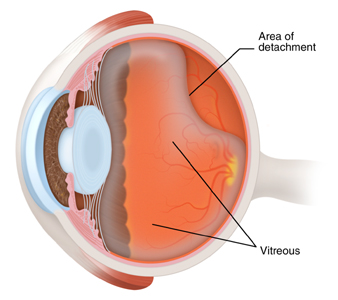Floaters
Specks or clouds moving in your field of vision as you look at a blank wall, white background on a computer screen, the snow when skiing, or a clear blue sky are known as floaters. Most people have some floaters normally, but do not notice them until they become numerous or more prominent.
Posterior vitreous detachment (PVD)
In most cases, floaters are part of the natural aging process. Floaters look like cobwebs, squiggly lines, or floating bugs. They appear to be in front of the eye but are floating inside. As we get older, the vitreous (the clear, gel-like substance that fills the inside of the eye) tends to shrink slightly and detach from the retina (as illustrated below), forming clumps within the eye. What you see are the shadows these clumps cast on the retina, the light-sensitive nerve layer lining the back of the eye. Most often, one notices all or part of a ring, known as the Weiss Ring, from where the vitreous was attached.

Flashes
The appearance of flashing lights comes from the traction of the vitreous gel on the retina at the time of vitreous separation. Flashes look like twinkles or lightning streaks. You may have experienced the same sensation if you were ever hit in the eye and “saw stars.” Once the vitreous separates from the retina, the flashing should stop.
Prognosis
Floaters can interfere with clear vision, particularly when reading. Try looking up and then down to move the floaters out of the way. While some floaters may persist, many will fade over time.
Floaters and flashes are sometimes associated with retinal tears. When the vitreous shrinks, it can pull on the retina, causing a tear. A tear may not be easily visualized on initial examination following a vitreous detachment and may evolve. We can image the peripheral retina with an Optos Optomap Scan with steering at the time of your visit to look for any small breaks in the peripheral retina. After the initial visit, you may be re-booked for a follow-up visit up to 6 weeks later, but you will be warned to return sooner. If new floaters appear suddenly or you see sudden flashes of light, see an ophthalmologist (Eye M.D.) immediately. A torn retina is a serious problem. It can lead to retinal detachment and blindness.
© 2025, 2009, 2007 Dr. Robert Schertzer Inc. based on 2007 The American Academy of Ophthalmology
